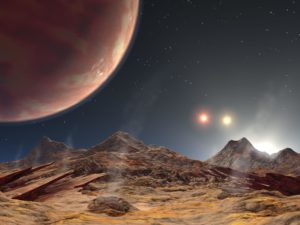
In the Universe, there are many planets orbiting around stars which are different from our Sun. They are called exoplanets. On 26 July 2020, all known extrasolar planets were 4301 in 3176 different planetary systems. The complete list of these planets is available within the list of confirmed extrasolar planets.
It is never easy to observe them, because they are small, far away and do not emit light! There are various methods to detect them: among the most used ones, is the method of transits as well as the method of radial speed. With the present activity, we will reproduce, thanks to a small friend, these two methods, and will understand together how the astronomers manage to go hunting for exoplanets.
The first method we will replicate is the method of transits, which is based upon measuring the star’s luminosity, and records its periodic dimming – which is almost imperceptible, but detectable by modern telescopes – which takes place when a planet transits in front of it, compared to us watching it.
The second method – the method of radial speed – uses the Doppler effect, namely the change in frequency of the radiation emitted by a source, due to the fact that the source is moving relative to the observer. The star – around which the planet rotates – is affected by the gravitational attraction of the planet itself, and moves a little bit, according to the planet’s position. These movements are reflected in changes in its radial speed (the velocity component of the star facing the observer), which can be detected by both ground and space telescopes. While observing the spectrum of the source, we can notice that the lines move towards the red when the star moves away from us, and towards the blue when it approaches.
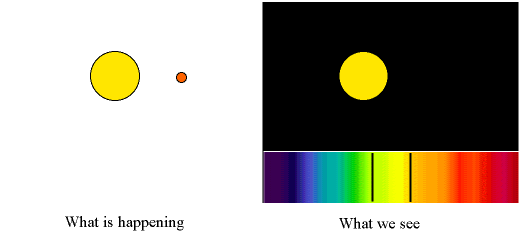
Here is what we need:
- Ozobot Evo, a small robot equipped with optical sensors, which enable it to reconognize the colours and move upon surfaces, both physical and digital, while following coloured paths;
- 3 coloured markers: blue, red and black
- 1 flashlight
- 1 white poster A1 format
- 1 pencil
- 1 projector
- sheets to print
The method of transits
In order to understand the Physics at the basis of this method, we will use the communication potentials of the small robot, which will be transformed into an exoplanet, orbiting around a star al outside our Solar System. Our observation will be qualitative, rather than quantitative: we will not measure luminosity, just as the astronomers do. Rather, we will only appreciate the decrease in brightness, which is sufficient in order to understand the fundamentals of this method.
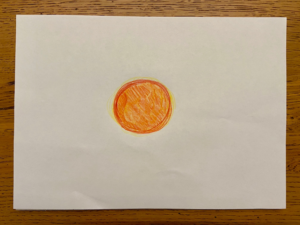
First of all, let us take the white poster, draw and colour a big star at the centre: this is the star of the Ozobot planet!
Then, with the markers made available by the Ozobot Evo kit, let us trace an orbit around the star, and with the support of a flashlight, we can simulate the light of the star. Each time the planet (Ozobot), while transiting, is placed between the star’s light and our point of view, it will provoke occultations. As a consequence, there will be variations of light, which will be detected by the researchers during the application of the method of transits.
Note that this method also allows to estimate the dimensions of the planet with respect to the star, and the geometry of its orbit. It is a simple, but very powerful method!

The method of radial speed
Here comes into play the mutual gravitational attraction of the planet and of its star. In order to show this method, Ozobot will simulate the star’s movements (and therefore the changes in its spectrum) which pass from the red to the blue line, and the other way around, each time it approaches or moves away from our point of view. The researchers record these variations, and that is how they discover the presence of a planet. Therefore, they are not looking for the planet, but rather for the speed variation of the star, induced by the planet! Ozobot will show the variation of colour thanks to its coloured led, which will change, becoming red and blue.
Now that we’ve figured out how researchers’ most used methods work, let us become planets’ hunters too.
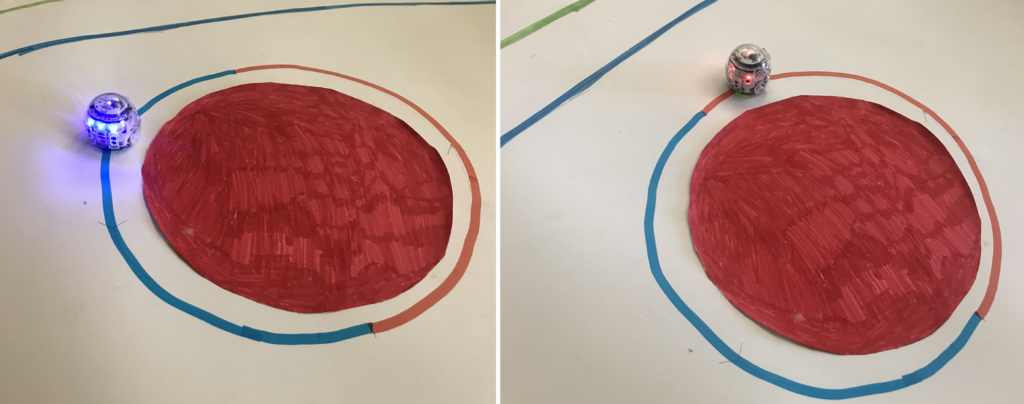
Let us use the first method: the method of transits.
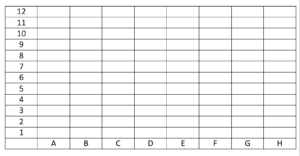 Project upon either a screen or a white wall these pictures and print the grid on the right (click on the picture in order to enlarge it). The pictures represent a stellar system, with an orange star and a small dark planet, which is in various positions of its orbit around the star. Observe picture A and the bar on the left, which indicates the star’s luminosity (in practice, it is as if the value of the bar was obtained with an instrument which is observing the star and is measuring its luminosity): which number is it showing? It is number 10, which represents the star’s luminosity when it is not obscured by a planet: place an X in the A-10 grid bok. Continue in this way for all pictures, until H. Unite all the X – from A to H – to see what comes up. Find the solution here.
Project upon either a screen or a white wall these pictures and print the grid on the right (click on the picture in order to enlarge it). The pictures represent a stellar system, with an orange star and a small dark planet, which is in various positions of its orbit around the star. Observe picture A and the bar on the left, which indicates the star’s luminosity (in practice, it is as if the value of the bar was obtained with an instrument which is observing the star and is measuring its luminosity): which number is it showing? It is number 10, which represents the star’s luminosity when it is not obscured by a planet: place an X in the A-10 grid bok. Continue in this way for all pictures, until H. Unite all the X – from A to H – to see what comes up. Find the solution here.
Let us use the second method: the method of radial speed.
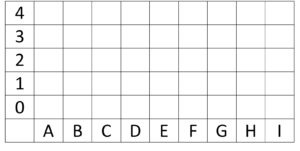 As you did for the previous method, project upon a screen or a white wall these pictures and print the grid on the right (click on the picture in order to enlarge it). In this case, you’ll see the orbit of the planet around its star, and the planet in different positions, according to the picture. Now have a look at picture A. What is the position of the star, with respect to the ruler below? It is placed in correspondence of 0. Therefore, put a X in the A-0 grid box. Continue in this way until the picture I. Unite all the X, from A to I, indicating each time where is the star with respect to the ruler. Find the solution here.
As you did for the previous method, project upon a screen or a white wall these pictures and print the grid on the right (click on the picture in order to enlarge it). In this case, you’ll see the orbit of the planet around its star, and the planet in different positions, according to the picture. Now have a look at picture A. What is the position of the star, with respect to the ruler below? It is placed in correspondence of 0. Therefore, put a X in the A-0 grid box. Continue in this way until the picture I. Unite all the X, from A to I, indicating each time where is the star with respect to the ruler. Find the solution here.
In real life, this is what researchers observe and study. As you can see, it is not so different from what you have obtained! If there had not been a planet around that star you were observing, the signal would have produced no curve.
Activity by Laura Leonardi and Serena Benatti, Inaf Osservatorio Astronomico di Palermo.

